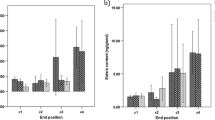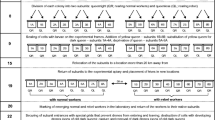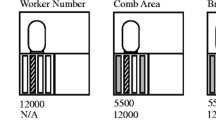Summary
Factors which may initiate queen rearing and swarming in colonies of Africanized honeybees are presented. These factors include colony size (comb area, worker population), patterns of comb utilization, congestion of brood and adult workers in the brood nest area, and worker age distribution. Factors not associated with queen rearing and swarming include volume of the potential nesting cavity and the ratio of nurse bees to brood, a measure of available brood food. A new multifactorial hypothesis for the initiation of swarming in honeybees is presented, based on intrinsic (demographic) and extrinsic (resource abundance) factors acting as primary stimuli to initiate queen rearing.
Resume
Les facteurs qui peuvent être à l'origine d'un élevage de reines et de la formation d'essaims dans les colonies d'abeilles domestiques africanisées sont les suivantes: — La taille de la colonie (surface couverte par les alvéoles et population d'ouvrières); — les types d'utilisation des alvéoles; — la surpopulation des larves et des ouvrières adultes dans la surface réservée au couvain; — la distribution des âges des ouvrières. Les facteurs qui ne sont pas liés à l'élevage des reines et à la formation d'essaims comprennent: — le volume des cavités de nidification et la proportion des nourrices par rapport au couvain (ce qui constitue une mesure de la quantité de nourriture disponible pour les larves). Nous formulons une nouvelle hypothèse multifactorielle sur l'origine de la formation des essaims d'abeilles domestiques: elle est fondée sur des facteurs intrinsèques (démographiques) et extrinsèques (l'abondance des ressources) agissant comme des stimuli «primaires» qui induisent l'élevage des reines.
Similar content being viewed by others
References
Allen M.D., 1956. — The behaviour of honeybees preparing to swarm.Br. J. Anim. Behav., 4, 14–22.
Avitable A., Kasinkas J.R., 1977. — The drone population of natural honeybee swarms.J. Apic. Res., 16, 145–149.
Bodenheimer F.S., 1937. — Studies in animal populations II. Seasonal population trends of the honey-bee.Qu. Rev. Biol., 12, 406–425.
Burgett D.M., Morse R.A., 1974. — The time of natural swarming in honey bees.Ann. Entomol. Soc. Am., 67, 719–720.
Butler C.G., 1954. — The method and importance of the recognition by a colony of honeybees of the presence of its queen.Trans. Roy. Entomol. Soc. London, 105, 11–29.
Butler C.G., 1960. — The significance of queen substance in swarming and supersedure in honeybee colonies.Proc. Roy. Entomol. Soc. London, 35, 129–132.
Daly H.V., Balling S.S., 1978. — Identification of Africanized honeybees in the western hemisphere by discriminant analysis.J. Kansas Entomol. Soc., 51, 857–869.
Demuth G.S., 1922. — The cause of swarming.Glean. Bee Cult., 50, 371–373.
Demuth G.S., 1931. — Cause of swarming is known.Am. Bee J., 71, 419.
Fell R.D., Ambrose J.T., Burgett D.M., Dejong D., Morse R.A., Seeley T., 1977. — The seasonal cycle of swarming in honeybees.J. Apic. Res., 16, 170–173.
Fletcher D.J.C., 1977. — A preliminary analysis of rapid colony development inApis mellifera adansonii. Proc. Eighth Int. Cong., Union for Study of Social Insects (Wageningen, Netherlands), 144–145.
Free J.B., 1965. — The allocation of duties among worker honeybees.Symp. Zool. Soc. London, 14, 39–59.
Gary N.E., Morse R.A., 1962. — The events following queen cell construction in honeybee colonies.J. Apic. Res., 1, 3–5.
Gerstung F., 1891–1926. — Der Bien und Seine Zucht. 7 edns. Berlin, Pfenningstorff.
Huber F. 1792. — Nouvelles observations sur les abeilles, I. (Transl. 1926, Hamilton, III: Dadant).
Lindauer M., 1952. — Ein Beitrag zur Frage der Arbeitseilung im Bienenstaat.Zeitschr. vergl. Physiol., 34, 299–345.Translation Bee World, 34, 63–73, 85–90.
Lindauer M., 1961. — Communication among social bees.Harvard Univ. Press, Cambridge, Mass., 161 p.
Morland D.M.T., 1930. — On the causes of swarming in the honeybeeApis mellifera: an examination of the brood food theory.Ann. Appl. Biol., 17, 137–147.
Perepelova L.I., 1928. — Laying workers, the ovipositing of the queen, and swarming.Bee World, 10, 69–71.
Perepelova L.I., 1947. — (Ways of increasing breeding in colonies.)Pchelovodstvo, 4, 10–14. (Translation, Bee Research Association.)
Ribbands R., 1953. — The behaviour and social life of honeybees.Bee Research Association Ltd, London, 352 p.
Seeley T., 1977. — Measurement of nest cavity volume by the honey beeApis mellifera.
Seeley T.D., 1979. — Queen substance dispersal by messenger workers in honeybee colonies.Behav. Ecol. Sociobiol., 5, 391–415.Behav. Ecol. Sociobiol., 2, 201–227.
Seeley T., Morse R., 1976. — The nest of the honeybee.Ins. Soc., 23, 495–512.
Simpson J., 1957. — Observations on colonies of honeybees subjected to treatments designed to induce swarming.Proc. Roy. Entomol. Soc. London, (A),32, 185–192.
Simpson J., 1958. — The factors which cause colonies ofApis mellifera to swarm.Ins. Soc., 5, 77–95.
Simpson J., 1959. — Variation in the incidence of swarming among colonies ofApis mellifera throughout the summer.Ins. Soc., 6, 85–99.
Simpson J., 1973. — Influence of hive space restriction on the tendency of honeybee colonies to rear queens.J. Apic. Res., 12, 183–186.
Simpson J., Greenwood P., 1975. — Results of restricting the brood space of honeybee colonies.J. Apic. Res., 14, 51–55.
Simpson J., Moxley E., 1971. — The swarming behaviour of honeybee colonies kept in small hives and allowed to outgrow them.J. Apic. Res., 10, 109–113.
Simpson J., Riedel B.M., 1963. — The factors that cause swarming by honeybee colonies in small hives.J. Apic. Res., 2, 50–54.
Taranov G.F., 1947. — (Occurrence and development of the swarming instinct in the colony.)Pchelovodstvo, 2, 44–54. (IBRA trans. E102.)
Winston M.L., 1978. — Intra-colony demography of the Africanized honeybee in South America. Ph. D. Dissertation,University of Kansas, Lawrence, Kansas, U.S.A.
Winston M.L., 1979. — Intra-colony demography and reproductive rate of the Africanized honeybee in South America.Behav. Ecol. Sociobiol., 4, 279–292.
Author information
Authors and Affiliations
Additional information
Contribution 1711 from the Department of Entomology, University of Kansas, Lawrence, Kansas 66045, U.S.A.
Rights and permissions
About this article
Cite this article
Winston, M.L., Taylor, O.R. Factors preceding queen rearing in the Africanized honeybee (Apis mellifera) in South America. Ins. Soc 27, 289–304 (1980). https://doi.org/10.1007/BF02223722
Received:
Accepted:
Issue Date:
DOI: https://doi.org/10.1007/BF02223722




